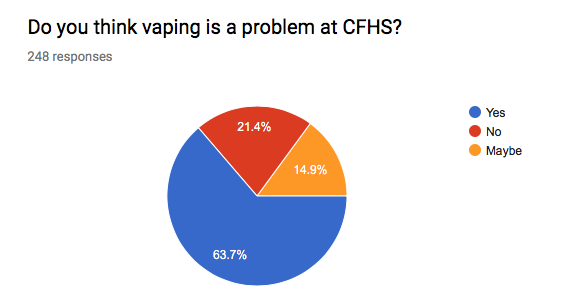FUMED: Majority of students want greater controls in stopping the ‘epidemic’ growth of vaping a problem at Cedar Falls High School

In 2016, the Iowa Youth Survey of high school students found that 14 percent of students had tried vaping, but the number of students vaping has surely risen since then. Last week, a Hi-Line of 248 students found that almost four out of every five respondents found vaping at the high school is or may be a problem.
Posters line the hallways of Peet and Holmes Junior High. Many of them carry typical school spirit phrases like “the Tiger Way,” but some of them have a very particular message, reading “It’s not cuul to juul in school.”
A “Juul” is the most popular brand of vape pen on the market, introduced in 2015 for tobacco smokers to quit smoking. A Juul has the unsuspecting appearance of a USB flash drive.
A 2016 Iowa Youth Survey by the Iowa Department of Public Health reported 14 percent of students said that they first tried an e-cigarette, vape pen, e-hookah, mod-box or other electronic cigarette by the time they were ages of 15 or 16 years old.
With the ages of vaping getting younger and younger, the Food and Drug Administration (F.D.A.) has called the use of vaping an “epidemic” for teenagers. Education on vaping usage in schools has increased since negative health effects of vaping has been revealed. Many of the health effects are still unknown because vaping is a fairly new nicotine delivery system.
“In our illegal drugs unit, we talked about nicotine usage very extensively, and we finished the unit by doing a whole lesson on vaping and Juuling,” UNI health student teacher Jay Teply said. “We had them make anti-smoking ads for the junior high schools because from what we have heard the usage of vape has started even earlier now in those schools. Having the students doing their own research themselves helps them educate on how harmful vaping actually is,” he said.
In an anonymous Tiger Hi-Line survey of 248 students conducted in September, 63.7 percent think that vaping is a problem in Cedar Falls High School.
According to one of the respondents to the survey, “Some see it as an addiction, and others as just a hobby. I started this activity not to anger my peers or act rebelliously, but as a way to escape the amount of stress life puts on a person’s shoulders. Maintaining good grades, preparing the best you can for college, while working 30-40 hours a week puts a strain on a person. The way that I saw it when I was first making my decisions in life is either to pick up one thing over another,” the respondent said.
Another respondent opposed underage vaping. “I believe vaping has become a problem in the school due to how widespread it is. People vape in class, in their cars and everywhere around school,” junior Niska Poleksic said.
In Cedar Falls High School, the vaping “epidemic” is a relevant topic.
“Vaping right now appears to be a safe alternative to smoking for students that think, ‘Hey, this is the pathway to being able to quit smoking and start vaping,’ when that shouldn’t be their solution,” Principal Jason Wedgbury said.
As a whole district, Cedar Falls Schools have had open dialog on vaping.
“The junior highs have been involved. This is a district-wide discussion,” Associate Principal Ethan Wiechmann said.
For teachers, their education on vaping is just as important as the students’.
“We had a tray of the ones that have been confiscated at our staff meeting to show the teachers what they are dealing with because for many of our teaching staff, they don’t understand how vaping works or what it looks like, especially the small USB-looking ones. We wanted to show them what they are looking for,” Wedgbury said.
With fruity and other enticing flavors, vape doesn’t seem harmful by the look and smell of it compared to a cigarette, but pods in vaping devices have a higher concentration of nicotine than individual cigarettes do. From a 2016 report by the National Academies of Science Engineering Medicine, chemicals present in e-cigarette aerosols have capability of causing DNA damage and cancer, and teenagers vaping increases teens’ chance of smoking cigarettes.
“The education piece on this topic is very important because many of our students perceive vaping as a safe alternative. Unfortunately, there was not a lot of research put into it before they let it out into the world,” Wiechmann said. “This is one of those things where they let it go, and now the F.D.A is realizing that it was a big mistake, and they are pulling back on that,” he said.
Yet, some students see vaping as relatively harmless and oppose a crackdown. “It’s only smoke. It’s not like it’s some illegal drugs,” a student reported in the survey.
Still, a majority of the student body said that the topic of vaping should be addressed. Of the students responding to the Tiger Hi-Line survey, 74.2 percent said the F.D.A’s prohibition on vaping or Juuls for people under 18 should be more strongly enforced.
Several students who supported greater enforcement were concerned about the health effects of this relatively new product. “I think that it is unhealthy and I don’t understand the draw to it. I think a lot of it is social, which is kind of sad to me. I wonder why you do it to your body if you know it will harm you in the future,” junior Devin O’Loughlin said. 








You must be logged in to post a comment Login